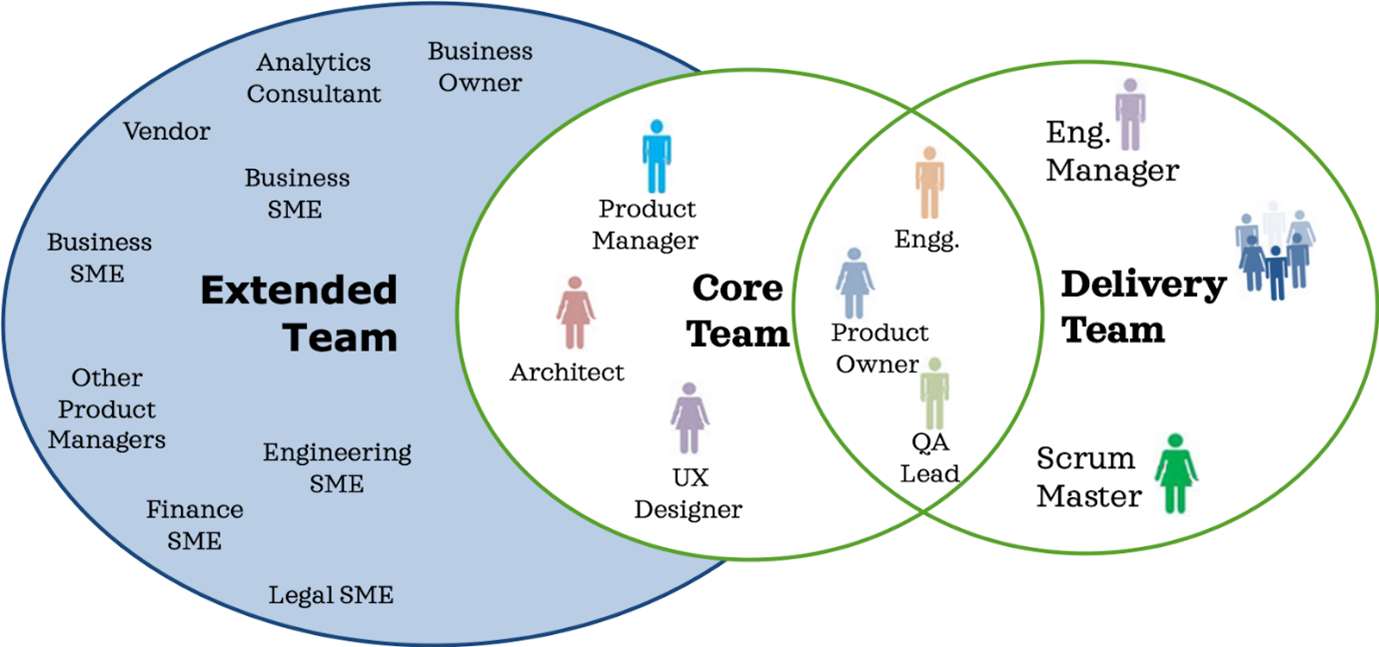Most companies struggle to reinforce their development team at market speed and with the right skill set.
That’s where an extended team comes in.
Picture this: you need some help for your development department. Coders are struggling with the amount of work they’re assigned. Programmers type as hard as they can. And coffee mugs just pile up in the sink. Creating a coding dream team right off the bat is difficult. This is where extended teams come into play.
What is an extended team?
An extended team is an extra pair of hands for your in-house team.
The extended team model is a form of outsourcing that involves closer proximity, communication, and cooperation between the in-house team and the outsourced team.

Instead of having a totally separate team on a certain project(s), companies reinforce their in-house team, while maintaining total control over the project and having staff involved in all aspects.
But an extended team is only one modality of the ETM, or Extended Team Model. There are several kinds of collaboration.
What are the key benefits of the extended team model?
The extended team model presents several benefits for businesses looking to expand their talent pool at speed
1. You’re always in the loop
The extended team model is designed for collaboration. Regular updates, shared progress reports, and integrated workflows mean you’re never in the dark. This approach ensures that the external team doesn’t feel like a separate entity but rather an embedded extension of your core operations. Over time, your in-house team absorbs these practices and skills, becoming stronger and more self-sufficient.
2. Your priorities = their priorities
Unlike some outsourcing models that juggle multiple clients and projects, the extended team model offers singular focus. Your business objectives are their roadmap, and your success is their benchmark. This alignment ensures that tasks, goals, and timelines are treated with the same level of care and commitment as if they were managed internally. It’s a partnership built on shared priorities and clear outcomes.
3. Access to global talent
Talent knows no borders, and neither should your business. The extended team model connects you to highly skilled professionals from around the globe without the logistics of relocation or hiring locally in competitive markets. This diversity brings fresh energy and innovation to your projects, giving your business a competitive edge.
4. Save serious time
Hiring the right people takes time, especially in competitive industries. Screening resumes, scheduling interviews, and onboarding can drag on for weeks – or months. The extended team model bypasses all that. Your external team is ready to jump in, equipped with the skills and experience needed for the job. This means projects start sooner, and you can stay ahead of tight deadlines.
5. Scaling becomes easier
The extended team model offers the flexibility to scale up when you’re tackling large projects or scale down during quieter periods. This agility allows you to respond to market changes without the risks and costs of permanent staff adjustments. It’s a model designed to grow – or shrink – on your terms.
6. Cost-effectiveness without cutting corners
Traditional in-house hiring comes with hefty costs: salaries, benefits, equipment, and office space. With an external team, you pay for expertise and results, not overheads. You gain access to top-tier talent and state-of-the-art tools without the long-term financial commitments, letting you allocate resources where they’re needed most.
7. Round-the-clock productivity
While your team wraps up for the day, your extended team in another part of the world is just getting started. This continuous workflow ensures progress never stalls, projects move faster, and deadlines are easier to meet. It’s like having your business running 24/7 without the burnout.
8. Specialized skills on demand
Every project has its unique demands, and finding specialists for short-term needs can be a struggle. The extended team model offers a ready-made pool of niche talent without the commitment of full-time hiring. These experts step in when you need them and step out when the project is done, ensuring you get top-tier skills on demand.
9. Fresh perspectives
Bringing in an external team means new ways of thinking and working. Extended teams come with diverse experiences and backgrounds, offering solutions you might not have considered. They’re not weighed down by internal politics or “the way we’ve always done it,” so they can spot opportunities and inefficiencies that your team might overlook.
10. Focus on core business
When the technical details and heavy lifting are handled by an external team, your in-house staff is free to focus on strategy and growth. They can dedicate their time to refining products, improving customer experiences, and exploring new markets – essentially, the activities that drive your business forward. It’s a smarter way to allocate resources and energy.
How does an extended team work?
The concept of an extended team is simple: it acts as a direct extension of your existing team, where everyone works together towards the same goals. Here’s how it works.
Assess your needs
We start by identifying the specific skills, roles, or expertise your project requires – the size of the team you need, the scope of the work, and the expected timeline.
Define the team structure
Then, we outline the team structure, including specific roles (e.g., developers, analysts, designers), experience levels, and technical or cultural fit criteria.
Onboarding the extended team
Once you have the right people, it’s time to onboard them.
- Introduction to your business: Provide the new team with an overview of your company, its mission, and how their role contributes to your goals.
- Set up communication tools: Integrate the team into your existing communication platforms (e.g., Slack, Microsoft Teams) and project management tools (e.g., Jira, Trello).
- Explain workflows: Share details about your processes, reporting structure, and decision-making protocols.
- Assign a point of contact: Designate a manager or team member as the primary liaison to streamline communication and address questions.
- Kick-off meeting: Host an initial meeting to align expectations, clarify objectives, and set the tone for collaboration.
Day-to-day collaboration
The extended team is ready to become a part of your internal operations. They can be part of meetings, share updates, and ensure active participation. Build a sense of ownership by involving them in decision-making processes where relevant.
Establish performance metrics
Define KPIs or milestones to track the extended team’s progress. Schedule regular reviews to ensure goals are being met and adjust workflows as needed.
Maintain open communication
Keep lines of communication open to address challenges, provide feedback, and celebrate successes.
Evaluate and scale as needed
Periodically review the collaboration to assess its effectiveness. If your business needs evolve, scale the team up or down by working with your provider to adjust the team’s size or expertise.
Extended Team models at Near Partner
At Near Partner we work with several models of nearshore. This is our way of work with customers all over the world in a nutshell.
Extended Team
Our extended team acts as an extension of your in-house staff, not as a replacement. The collaboration in this model relies on providing additional business and technical expertise to your team, bridging skill gaps in your core staff.
That being said, you and your business keep complete control over whichever project or task is at hand. The communication between you, your in-house team, and our extended team is continuous and direct. Your staff and our off-site developers function as a single tight-knit unit.
As a result, all team members (both in-house and outsourced) share responsibility. Both teams are equally invested in building the product, and both teams are equally responsible for its success or failure.
Managed Team
A managed team, which in the end acts as an extension of your current team, works slightly differently from the Extended Team model. After outlining the project requirements – in terms of skills, number of team members, timeframe, etc – we assign a dedicated team and the team members’ respective roles (Software Developers, PM’s, Engineers, or others) to your business.
While the managed team can work closely with your in-house team, the level of collaboration is for you to decide. However, all responsibility and accountability for the project lie at our end. We will build the product and focus on providing the expected results.
Basically, we assume the management of an area or process, but report directly to you and to your business.
Project Team
The third kind of the ETM at Near Partner is the Project Team. This means that you, as our client, share your vision and product requirements with our team. Our skilled programmers will then help refine the concept by assessing your solution’s goals, scope, limitations, and target personas, and assume the execution and management of said project.
This means settling on a schedule that includes key milestones, timeline estimates, delivery schedule, and budget requirements. But although the execution and management are up to us, you and your business will always be engaged with our team in regular meetings and presentations, and a dedicated Project Manager will always be there to inform you on the progress, and to answer any question or issue you may have.
At Near Partner we have your ideal extended team
Our team at Near Partner is a pool of highly qualified engineers and developers, with several areas of expertise and years of experience in different sectors. Paired with our clients’ wishes, we are able to rapidly build complete teams, ready to work on your projects, from project management to testing. Our teams will ramp up your software development capabilities and reduce time-to-market. Are your projects moving faster than your company can manage them? Fret not, we’ll help you speed up the workflow.
All in all, at Near Partner we see ourselves as true partners, meaning we devote ourselves to our clients’ business endeavors, sharing in the culture, the challenges and the achievements. This is what we have been doing for the last four years.
Get your hands on our free eBook “Outsourcing 101”, and clear all the doubts you might have about outsourcing. Or, better yet, get in touch and let us advise you and help you find the best solution for your business.





